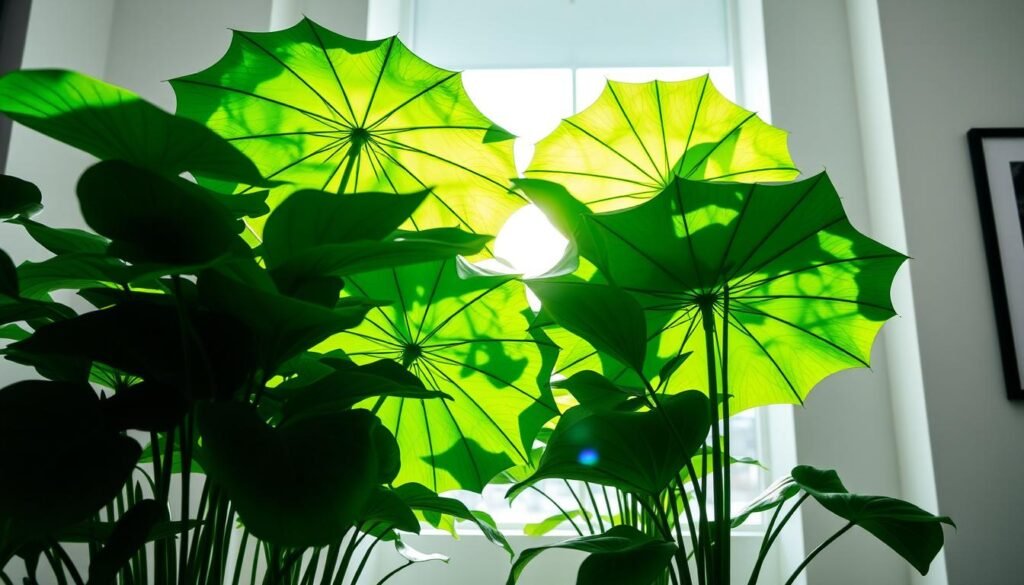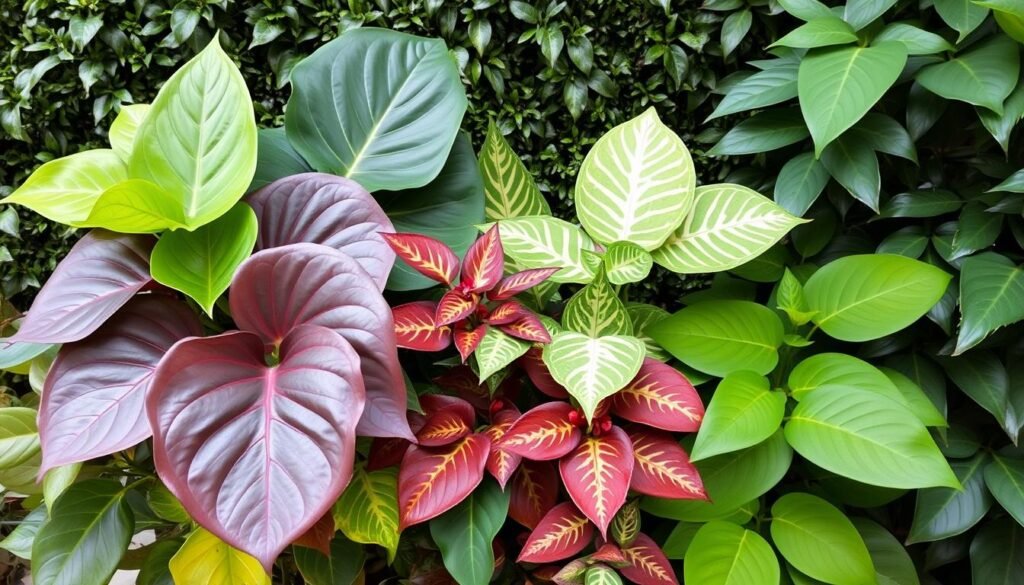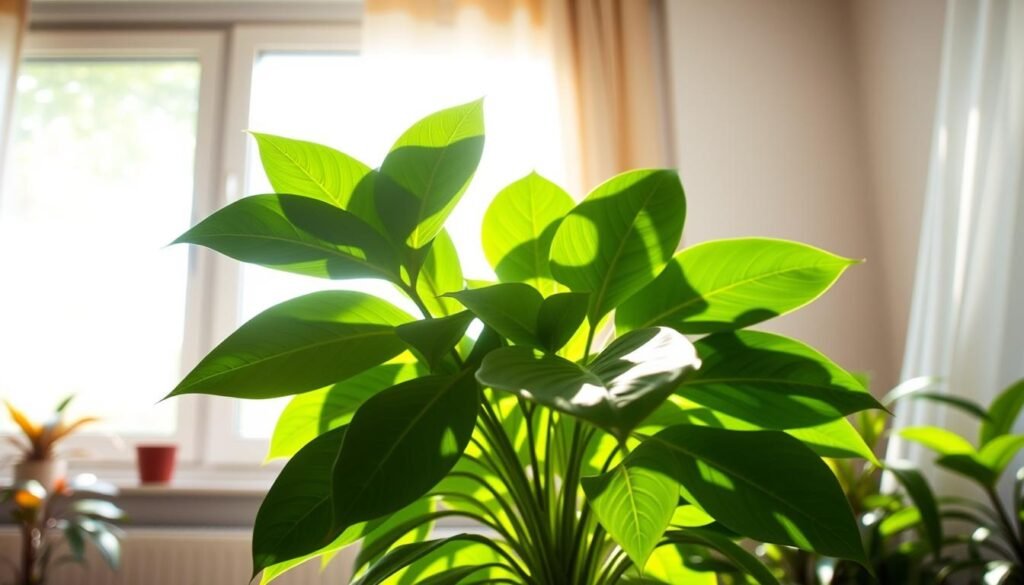The Schefflera is a standout in houseplants, known for its unique leaf shape and vibrant green color. These tropical plants add elegance to any home. Varieties like the dwarf umbrella tree and the grand Schefflera actinophylla are great for those who love houseplant care.
To keep your umbrella plant thriving, it’s important to know its care needs. This includes light, water, soil, and humidity. Scheffleras can adapt to indoor conditions but need attention to grow well. With the right care, they can live for decades, growing beautifully with little effort.
In this guide, you’ll learn how to keep your Schefflera healthy and vibrant. This will make your umbrella plant a beautiful addition to your home.
Table of Contents
Introduction to Schefflera
Schefflera, also known as umbrella plants, come from the tropical areas of Asia, Africa, Australia, and the Pacific Islands. They can grow up to 2 to 10 feet tall, fitting well in many indoor spaces. Their long, oval leaves spread out from a central stalk, giving them a beautiful canopy look. While they can flower, indoor types mainly focus on their stunning leaves.
Knowing how to care for Schefflera is key for their health. They like temperatures between 65 to 75 degrees Fahrenheit during the day. They also prefer high humidity, around 60 percent, for the best growth. If kept in good conditions, Schefflera can grow a lot in the summer, even more so if they’re outside.

It’s important for pet owners to know that Schefflera can be toxic to humans and pets. Regular care, enough light, and cleaning keep them looking great. Repotting every two to three years and watering right are also key for Schefflera care.
| Details | Specifications |
|---|---|
| Genus Name | Schefflera spp. |
| Height | 2 to 10 feet |
| Width | 3 to 6 feet |
| Temperature Preference | 60-75°F (15-24°C) |
| Humidity Level | 60% |
| Hardiness Zones | 10 to 12 |
| Watering Frequency | Once a week |
| Fertilization | Monthly during spring and summer |
| Common Pests | Mealybugs, mites, scale insects |
Understanding the Types of Umbrella Plants
The Schefflera genus has over 600 species, with two main types for indoor use: Schefflera arboricola and Schefflera actinophylla. These plants bring greenery and improve your indoor care routine.
Schefflera arboricola, or the dwarf umbrella tree, has small, shiny leaves. It grows compactly, perfect for small spaces. Schefflera actinophylla, on the other hand, can grow tall and has wider leaves. It thrives outdoors, becoming a large tree.
Knowing the differences between these Schefflera varieties helps you pick the best plant for your home. Both need similar care but understanding their specific needs can make your gardening better.
| Feature | Schefflera arboricola | Schefflera actinophylla |
|---|---|---|
| Common Name | Dwarf Umbrella Tree | Australian Umbrella Tree |
| Height Indoors | 30 cm – 200 cm (1 – 7 ft) | Up to 2 m (6.5 ft) |
| Leaf Type | Smaller, glossy | Broader, larger |
| Growth Rate | Up to 30 cm (12 in) per year | Faster when in suitable conditions |
| Temperature Preference | 15°C to 21°C (59°F – 70°F) | Prefers warmer environments |
| Ideal Lighting | Bright, indirect sunlight | Can tolerate direct sunlight |
By understanding these differences, you can better care for your umbrella plants. This will help them stay healthy and beautiful.

Essential Light Requirements for Schefflera
Schefflera plants do best in certain light conditions. This ensures they grow well and stay healthy. Knowing what light your umbrella plant needs is key for good care.
Bright, indirect light is best for Schefflera. They can handle lower light, but too little can make them leggy and slow-growing. Keep your Schefflera near a window for filtered light or in a bright room.
Don’t put your Schefflera in direct sunlight. It can burn the leaves and slow growth. In summer, move it outside to a shaded spot for the right amount of sun.

By following these tips, your Schefflera will stay green and healthy. Check its light often to make sure it’s just right for growth.
Watering Guidelines for Umbrella Plant Care
Proper watering is key for a healthy umbrella plant. It’s important to keep the soil just right. Water your plant when the top inch of soil feels dry. This usually means watering once a week.
If your plant is in a 5-inch pot and not in direct sunlight, use 0.5 cups of water every 9 days. In winter, when the plant grows slower, water it less often.
Watering thoroughly until water drains from the pot is a good rule. This helps prevent root rot. Adjust your watering schedule to keep the soil moist but not too wet. This creates a great environment for your umbrella plant.

Soil and Potting Recommendations
To keep your Schefflera healthy, focus on the right soil. These plants love rich, well-draining soil. This type of soil holds some moisture but lets water drain. Choose a potting mix made for indoor plants.
Choose a pot with good drainage holes. This stops water from pooling and causing root rot. Young Scheffleras need a new pot every year. Older ones should get a new pot every two to three years. This helps them grow well and prevents them from becoming too tight in their pots.
The soil’s pH should be between 6.0 to 6.5. This is slightly acidic, matching the Schefflera’s natural home. Keeping the soil right helps your plant grow strong and healthy.
| Age of Plant | Repotting Frequency | Soil Type |
|---|---|---|
| Young Schefflera | Annually | Rich, well-draining soil |
| Older Schefflera | Every 2-3 years | Loamy potting mix |
In short, the right soil conditions and repotting are key. They help your Schefflera stay healthy and vibrant.
Humidity Levels for Healthy Schefflera Growth
Keeping the right humidity is key for your Schefflera’s health. These tropical plants love a humid environment, best between 50% to 60% humidity. In winter, indoor humidity often drops, so it’s important to help your plant.
To fight low humidity, mist your Schefflera often or use a humidity tray. These methods mimic its natural home and prevent problems like brown leaves and pests. Watch your plant for signs of stress, like droopy leaves or browning.
Use a hygrometer to check your plant’s humidity. If it’s too low, your Schefflera might not grow well. Always check the soil’s top third for dryness before watering to avoid harming your plant.
Focus on humidity to keep your Schefflera happy and healthy. With the right care, it can live over twenty years.
Nourishing Your Plant: Fertilization Tips
Feeding your Schefflera correctly is key for vibrant growth and health. Here are some tips for fertilizing:
- Timing: Fertilize during the growing season, spring and summer. This is when your Umbrella Plant needs nutrients the most.
- Frequency: Use a balanced liquid fertilizer every two weeks. This keeps your plant well-nourished and growing.
- Granular Options: Try slow-release granular fertilizers at the start of the growing season. They release nutrients slowly over time.
- Adjustment: In fall and winter, reduce or stop fertilizing. This matches the plant’s natural dormant period, avoiding stress.
- Watering: Water your Schefflera after fertilizing. This prevents root burn and helps nutrients reach the soil.
When picking fertilizers, look at the N-P-K ratio. A balanced ratio, like 10-10-10, feeds plants well. Watch for signs of over-fertilizing, like yellow leaves or a white crust on the soil. If you see these, flush the soil with water to remove excess salts.
| Fertilizer Type | Application Frequency | Best for |
|---|---|---|
| Liquid Fertilizer | Every 2 weeks (Spring/Summer) | Immediate nutrient boost |
| Slow-Release Granules | Once at the start of the season | Continuous nutrient supply |
By using these fertilization tips, you’ll feed your Schefflera well. This will keep it healthy and beautiful in your home.
Common Problems in Schefflera Care
Caring for your Schefflera can sometimes present challenges. Knowing common problems helps keep your plant healthy. Leaf shedding is often a first sign of trouble. It might mean the plant is stressed from temperature changes or wrong watering.
Not watering enough can cause dry, crispy leaves. It’s key to watch your plant’s water needs. Let the soil dry a bit between waterings to avoid root rot from too much water.
Pests like spider mites, mealybugs, scale insects, and aphids can also be a problem. Regular checks and cleaning can help stop these pests. Using organic insecticidal soap is a good way to keep your plant healthy.
Pruning in spring helps your Schefflera grow bushier. But, don’t cut too much off, as it can stress the plant. Also, using the right pot size helps avoid common issues.
| Common Problem | Symptoms | Solutions |
|---|---|---|
| Leaf Shedding | Dropping leaves, environmental stress | Maintain consistent temperatures, monitor watering |
| Yellowing Leaves | Discoloration, overwatered condition | Adjust watering frequency, ensure proper drainage |
| Dry, Crispy Leaves | Underwatering signs | Increase watering, maintain humidity levels |
| Pest Infestations | Visible pests on leaves | Regular inspections, use insecticidal soap |
| Root Rot | Wilting, soggy soil | Allow soil to dry, improve drainage |
Conclusion
Caring for your Schefflera, also known as the umbrella plant, is key. You need to understand its needs for light, water, soil, humidity, and nutrition. By following these steps, your Schefflera will not only look great but also improve your home’s air quality.
Keep an eye on your plant and make changes as needed. For example, let the top inch of soil dry out before watering. Also, keep the humidity level at least 60 percent. With the right care, your Schefflera can live for over twenty years, adding life and color to your home.
Whether you’re new to caring for umbrella plants or have experience, these tips will help. Remember, regular feedings and the right lighting are important. This will ensure your Schefflera thrives, bringing beauty to your space for years to come.



